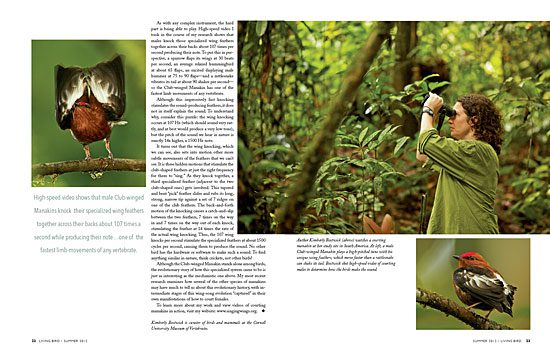Singing With His Wings: the Club-winged Manakin’s Display
By Kimberly Bostwick; Photographs by Tim Laman
July 8, 2012

A male Club-winged Manakin looks like a pretty normal bird, but nothing could be further from the truth. He shows his true nature when a female arrives—a few quick flights among tree branches, a deep bow followed by a backwards jig on his perch, and two quick flicks of his wings at his hoped-for lover-to-be. Although all of these antics are still “normal” for a manakin (of which there are more than 40 species found throughout Central and South America), what is special about this particular species is the sound that springs forth from those flicked wings: a humming, whining ting sound, like a simple note on a mini-violin.
Birds can produce a myriad of sounds vocally, and many other species of manakins make simple wing sounds. What is so spectacular about the club-wing’s sound is how it is made. Specifically, the club-wing’s note would be impossible for any bird with normal anatomy to reproduce. But a male Club-winged Mannakin doesn’t have normal anatomy; he has a pair of club-shaped wing feathers, one pair for each wing, and these feathers have the special property of being able to resonate, if stimulated correctly, emitting sound at the frequency of his love song. He also has uniquely massive and solidified wing bones, as well as enlarged wing muscles, which together with the feathers form a left and right pair of instruments that rest on the males’ backs (literally “lying in wait” for the next female visitor).
As with any complex instrument, the hard part is being able to play. High-speed video I took in the course of my research shows that males knock those specialized wing feathers together across their backs about 107 times per second producing their note. To put this in perspective, a sparrow flaps its wings at 30 beats per second, an average relaxed hummingbird at about 65 flaps, an excited displaying male hummer at 75 to 90 flaps—and a rattlesnake vibrates its tail at about 90 shakes per second— so the Club-winged Manakin has one of the fastest limb movements of any vertebrate.


Although this impressively fast knocking stimulates the sound-producing feathers, it does not in itself explain the sound. To understand why, consider this puzzle: the wing knocking occurs at 107 Hz (which should sound very rattly, and at best would produce a very low tone), but the pitch of the sound we hear in nature is exactly 14x higher, a 1500 Hz note.
It turns out that the wing knocking, which we can see, also sets into motion other more subtle movements of the feathers that we can’t see. It is these hidden motions that stimulate the club-shaped feathers at just the right frequency for them to “sing.” As they knock together, a third specialized feather (adjacent to the two club-shaped ones) gets involved. This tapered and bent “pick” feather slides and rubs its long, strong, narrow tip against a set of 7 ridges on one of the club feathers. The back-and-forth motion of the knocking causes a catch-and-slip between the two feathers, 7 times on the way in and 7 times on the way out of each knock, stimulating the feather at 14 times the rate of the actual wing knocking. Thus, the 107 wing knocks per second stimulate the specialized feathers at about 1500 cycles per second, causing them to produce the sound. No other bird has the hardware or software to make such a sound. To find anything similar in nature, think crickets, not other birds!
Although the Club-winged Manakin stands alone among birds, the evolutionary story of how this specialized system came to be is just as interesting as the mechanistic one above. My most recent research examines how several of the other species of manakins may have much to tell us about this evolutionary history, with intermediate stages of this wing-song evolution “captured” in their own manifestations of how to court females.


All About Birds is a free resource
Available for everyone,
funded by donors like you





